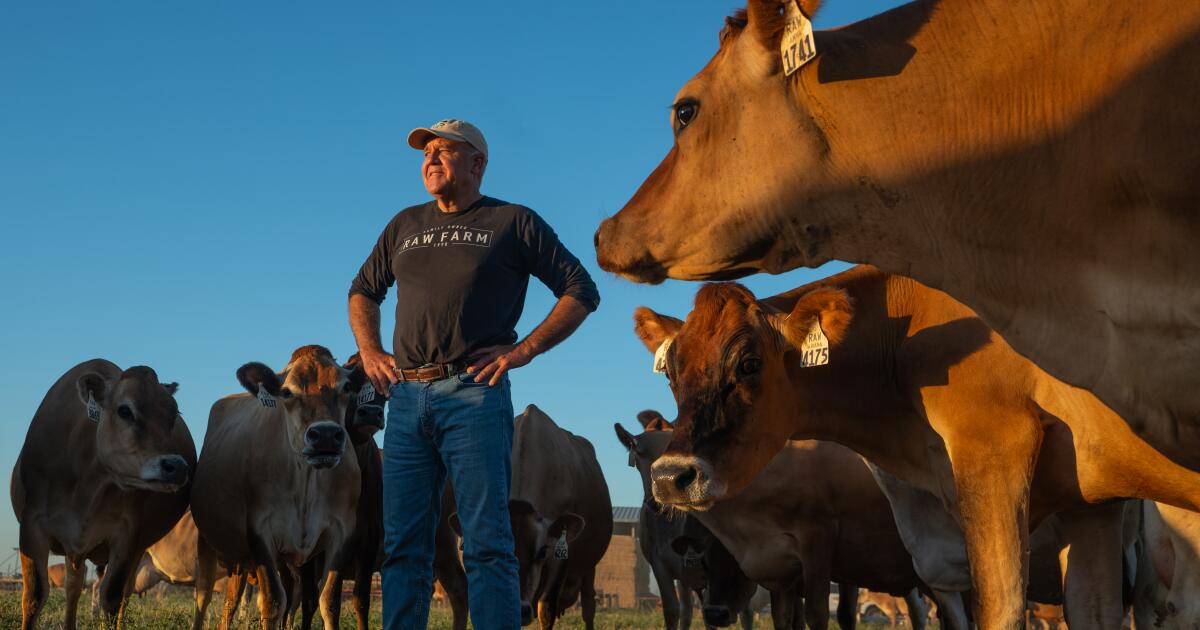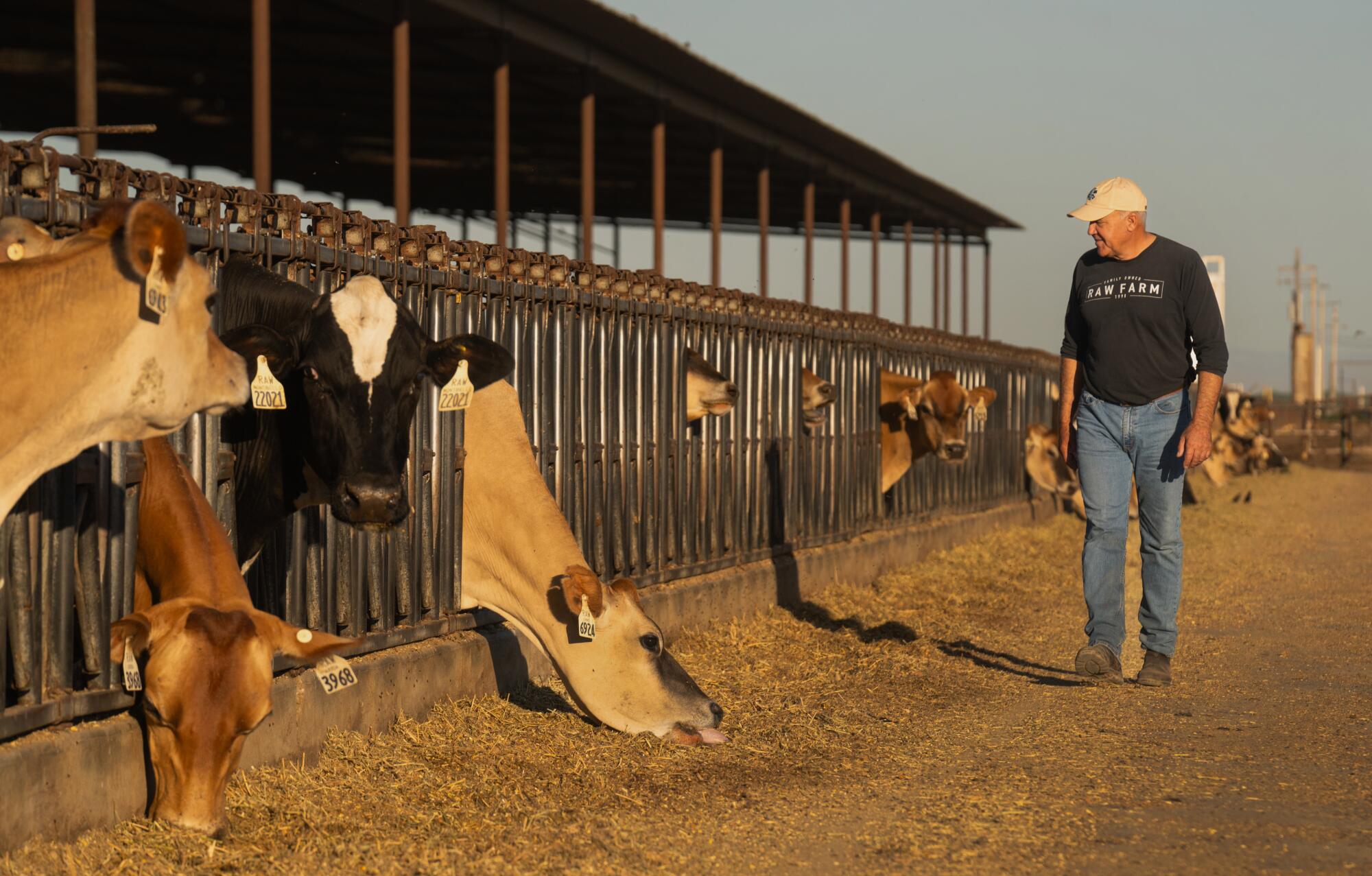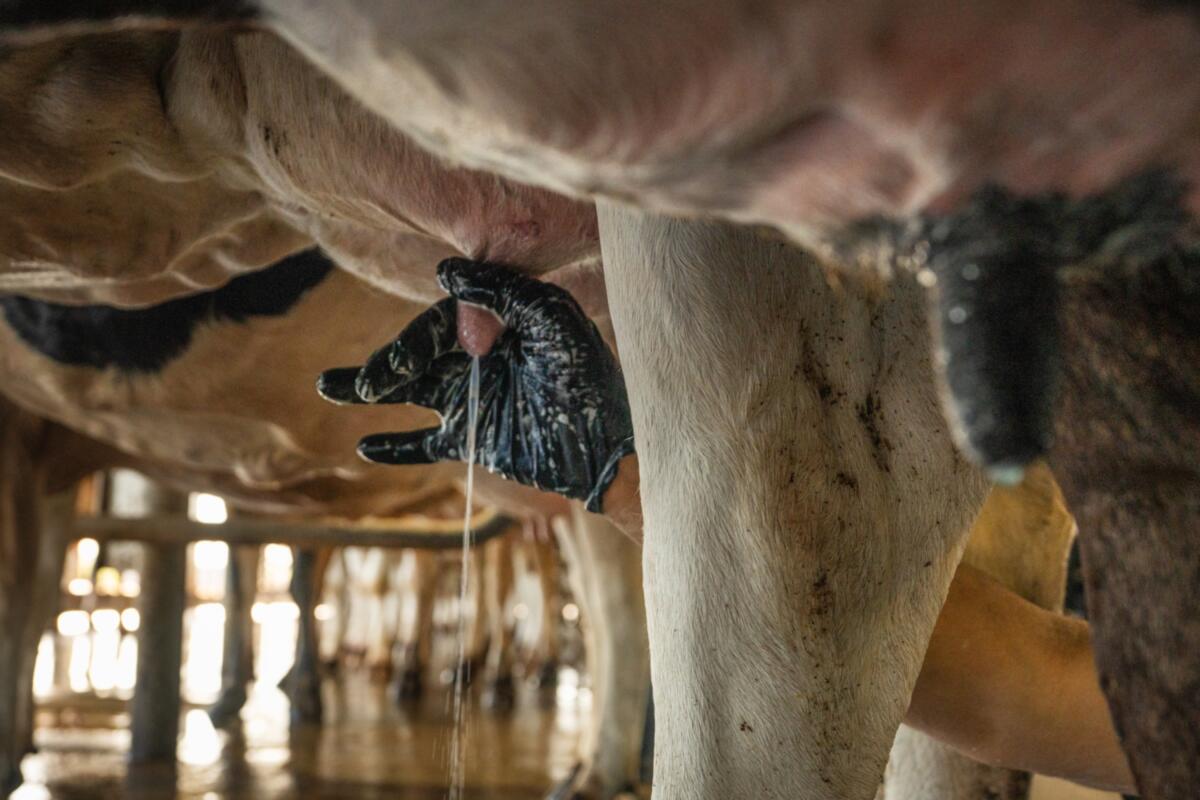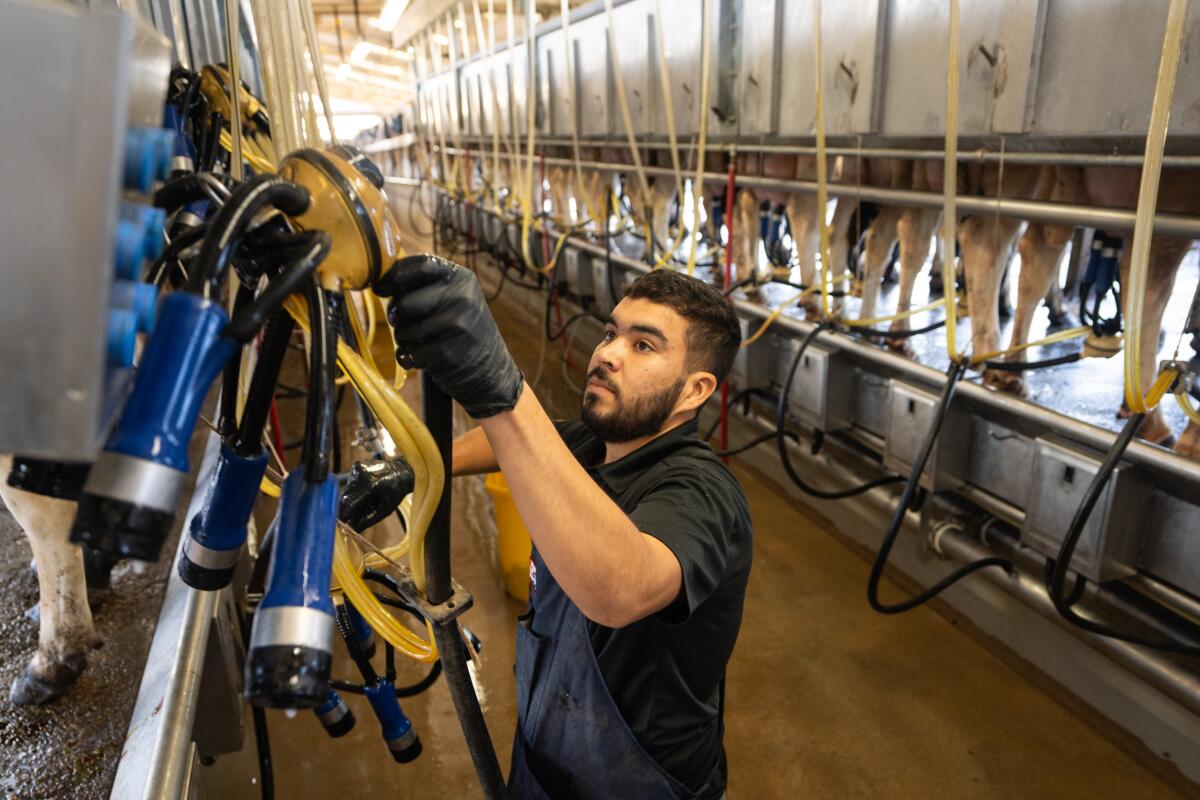Science
He reported a possible H5N1 outbreak in dairy cows. It took officials weeks to respond

The virus has — so far — caused only minimal illness among humans, yet has spread rapidly among birds, sea mammals and other species with devastating effect.
Although U.S. health officers have repeatedly assured Americans that H5N1 bird flu poses little risk to their well-being, some experts have become increasingly critical of what they see as the government’s failure to aggressively monitor the spread of virus among cattle and other farm animals. The virus has been reported in 145 dairy herds across 12 states, but critics say this is likely an underestimate.
They point to stories they have heard anecdotally from physicians and veterinarians in farming communities about mystery illnesses and cover-ups. And they point to perplexing “hits” of H5N1 in municipal wastewater far from any infected dairy herds.
“I think our government officials are are not doing the thorough investigation they should be doing,” said Rick Bright, a virologist and the former head of the U.S. Biomedical Advanced Research and Development Authority. “I think they are continually minimizing this outbreak and this virus.”
The worry among some experts is that H5N1-infected farm animals could serve as “mixing vessels” for new viral strains that could more easily infect people. They point to research released this week showing that the virus has receptors for both birds and humans. And they note that up to 75% of human infectious diseases are derived from pathogens that originated from animals.
Now, amid this heated debate over viral monitoring, a raw milk dairy farmer and longtime critic of the Food and Drug Administration has accused the government of ignoring his tip about a suspected H5N1 outbreak among a herd of dairy cows in early May.
Cows leave a dairy barn after milking.
(Tomas Ovalle/For The Times)
Although it remains unclear whether an outbreak actually occurred, neither federal nor state officials investigated the matter for weeks. Only after inquiries by The Times did officials announce Tuesday that they would look into the report.
The delayed response, some experts say, suggests a disturbing lack of oversight on the part of government officials.
“I think that once everybody decided it wasn’t going to kill people and pasteurized milk and herds could get over it, then all that was left was to take these stopgap measures — voluntary reporting, voluntary testing, testing when going across state lines — that don’t look anything like a really serious effort to go ahead and stamp it out,” said Michael Payne, a researcher and outreach coordinator at the Western Institute for Food Safety and Security at UC Davis.
The outbreak claim comes from Mark McAfee, owner of Raw Farms, a raw milk dairy producer with herds in Fresno and Hanford. On June 17, McAfee — who is also the president of the Raw Milk Institute, an advocacy group — emailed the FDA’s acting director, Donald Prater, to say that he’d been told a raw milk dairy herd had been infected and that people had probably consumed the contaminated milk.
According to McAfee’s email, which was shared with The Times, a subset of a farmer’s cows were suffering yellowish, runny diarrhea; low milk production; thick, yellowish colostrum; and general weakness. The farmer told McAfee he had separated the sick cows — about 10% of his herd — and discontinued milking them.

Mark McAfee walks by cows feeding at his raw milk dairy.
(Tomas Ovalle/For The Times)
“The farmer reported that for certain, humans had consumed the raw milk at some level,” McAfee wrote to Prater, adding that the farmer’s veterinarian “told the farmer to not report anything to anyone” because the virus would pass and “he did not want the FDA to swoop in and cause a media frenzy.”
McAfee said he fields lots of questions and calls from raw milk farmers around the nation. Because he’s president and founder of the Raw Milk Institute — and the largest producer of raw milk in the country — his advice and counsel is often sought by smaller dairy farmers.
Within 90 minutes of sending the email, Prater responded that he appreciated the time McAfee had taken to write the note and “for sharing these perspectives.” He then added that he and his agency would “take note of the points you raised and come back to you if we have any questions.”
According to McAfee, the FDA did not follow up with him. The state of New Mexico, where McAfee says the herd was infected, was made aware of the tip only last week, after the Times inquired.
The U.S. Department of Agriculture and the Centers for Disease Control and Prevention would not comment for the record on the matter, referring questions to the state.
Critics say whether the outbreak occurred or not, the lack of an immediate, or even timely, response underscores the absence of urgency and leadership in the face of a potential health threat.
“If you turn your back on this virus, you’re kind of inviting it in to bite you in the ass,” said Bill Hanage, associate professor of epidemiology and co-director of the Center for Communicable Disease Dynamics at Harvard University’s T.H. Chan School of Public Health.
Bright, the virologist, said the delay was a problem.
1

2

3

1. Carlos Rodriguez squeezes a cows teat to check the quality of the milk coming out of it. 2. Alvaro Hernandez hangs a milking cluster high to avoid contamination after a cow has been milked. 3. Mark McAfee checks bacteria levels in his raw milk every day and spends over $300,000 on testing. (Tomas Ovalle/For The Times)
“This is the stuff that drives me crazy,” Bright said. “I always tell people, it’s not necessarily the data that we have in front of us that’s most concerning. It is what’s being hid from us that’s most concerning.”
Farmers do not have to let government officials test their cattle, he said, which makes it hard to verify weeks after the fact whether an outbreak had occurred. If a dairy farmer allowed it, researchers could check for H5N1 antibodies in the blood.
“I really don’t think they want to know,” he said of the U.S. government, and the FDA in particular.
To be sure, the FDA and McAfee’s Raw Milk Institute have had a long, contentious history.
“To be quite frank, your source, Raw Milk Institute, are known advocates for repeatedly amplifying what they say is a lack of evidence that drinking raw milk with H5N1 is bad for you,” said Janell Goodwin, an FDA spokeswoman.
Indeed, McAfee said he reported the outbreak because he believed it showed that unpasteurized, yet infected raw milk was not a threat.
“No one got sick from that outbreak,” he insisted.

Mark McAfee, a raw milk dairy farmer and longtime critic of the FDA, has accused officials of ignoring his tip about a possible H5N1 outbreak among dairy cows.
(Tomas Ovalle/For The Times)
But epidemiologists The Times spoke with expressed skepticism on this point, suggesting that maybe nobody had “reported” being sick, noting that many dairy workers are migrants who may not relish a government visit. And they pointed to experimental and observational studies of barn cats that consumed H5N1 contaminated raw milk and “had about a 50% mortality rate and really unpleasant symptoms,” said Hanage, the Harvard professor.
Drinking raw milk is “something that is a risk that we would rather people didn’t take just for their own sake,” he said.
McAfee noted that he has received a certificate of good standing by California’s Department of Food and Agriculture for voluntarily testing his cows’ milk for H5N1. A spokesman for the agency confirmed that as of July 1, the farm’s milk was clear of the virus.

Science
California confirms first measles case for 2026 in San Mateo County as vaccination debates continue

Barely more than a week into the new year, the California Department of Public Health confirmed its first measles case of 2026.
The diagnosis came from San Mateo County, where an unvaccinated adult likely contracted the virus from recent international travel, according to Preston Merchant, a San Mateo County Health spokesperson.
Measles is one of the most infectious viruses in the world, and can remain in the air for two hours after an infected person leaves, according to the CDPH. Although the U.S. announced it had eliminated measles in 2000, meaning there had been no reported infections of the disease in 12 months, measles have since returned.
Last year, the U.S. reported about 2,000 cases, the highest reported count since 1992, according to CDC data.
“Right now, our best strategy to avoid spread is contact tracing, so reaching out to everybody that came in contact with this person,” Merchant said. “So far, they have no reported symptoms. We’re assuming that this is the first [California] measles case of the year.”
San Mateo County also reported an unvaccinated child’s death from influenza this week.
Across the country, measles outbreaks are spreading. Today, the South Carolina State Department of Public Health confirmed the state’s outbreak had reached 310 cases. The number has been steadily rising since an initial infection in July spread across the state and is now reported to be connected with infections in North Carolina and Washington.
Similarly to San Mateo’s case, the first reported infection in South Carolina came from an unvaccinated person who was exposed to measles while traveling internationally.
At the border of Utah and Arizona, a separate measles outbreak has reached 390 cases, stemming from schools and pediatric centers, according to the Utah Department of Health and Human Services.
Canada, another long-standing “measles-free” nation, lost ground in its battle with measles in November. The Public Health Agency of Canada announced that the nation is battling a “large, multi-jurisdictional” measles outbreak that began in October 2024.
If American measles cases follow last year’s pattern, the United States is facing losing its measles elimination status next.
For a country to lose measles-free status, reported outbreaks must be of the same locally spread strain, as was the case in Canada. As many cases in the United States were initially connected to international travel, the U.S. has been able to hold on to the status. However, as outbreaks with American-origin cases continue, this pattern could lead the Pan American Health Organization to change the country’s status.
In the first year of the Trump administration, officials led by Health Secretary Robert F. Kennedy Jr. have promoted lowering vaccine mandates and reducing funding for health research.
In December, Trump’s presidential memorandum led to this week’s reduced recommended childhood vaccines; in June, Kennedy fired an entire CDC vaccine advisory committee, replacing members with multiple vaccine skeptics.
Experts are concerned that recent debates over vaccine mandates in the White House will shake the public’s confidence in the effectiveness of vaccines.
“Viruses and bacteria that were under control are being set free on our most vulnerable,” Dr. James Alwine, a virologist and member of the nonprofit advocacy group Defend Public Health, said to The Times.
According to the CDPH, the measles vaccine provides 97% protection against measles in two doses.
Common symptoms of measles include cough, runny nose, pink eye and rash. The virus is spread through breathing, coughing or talking, according to the CDPH.
Measles often leads to hospitalization and, for some, can be fatal.
Science
Trump administration declares ‘war on sugar’ in overhaul of food guidelines

The Trump administration announced a major overhaul of American nutrition guidelines Wednesday, replacing the old, carbohydrate-heavy food pyramid with one that prioritizes protein, healthy fats and whole grains.
“Our government declares war on added sugar,” Health and Human Services Secretary Robert F. Kennedy Jr. said in a White House press conference announcing the changes. “We are ending the war on saturated fats.”
“If a foreign adversary sought to destroy the health of our children, to cripple our economy, to weaken our national security, there would be no better strategy than to addict us to ultra-processed foods,” Kennedy said.
Improving U.S. eating habits and the availability of nutritious foods is an issue with broad bipartisan support, and has been a long-standing goal of Kennedy’s Make America Healthy Again movement.
During the press conference, he acknowledged both the American Medical Association and the American Assn. of Pediatrics for partnering on the new guidelines — two organizations that earlier this week condemned the administration’s decision to slash the number of diseases that U.S. children are vaccinated against.
“The American Medical Association applauds the administration’s new Dietary Guidelines for spotlighting the highly processed foods, sugar-sweetened beverages, and excess sodium that fuel heart disease, diabetes, obesity, and other chronic illnesses,” AMA president Bobby Mukkamala said in a statement.
Science
Contributor: With high deductibles, even the insured are functionally uninsured

I recently saw a patient complaining of shortness of breath and a persistent cough. Worried he was developing pneumonia, I ordered a chest X-ray — a standard diagnostic tool. He refused. He hadn’t met his $3,000 deductible yet, and so his insurance would have required him to pay much or all of the cost for that scan. He assured me he would call if he got worse.
For him, the X-ray wasn’t a medical necessity, but it would have been a financial shock he couldn’t absorb. He chose to gamble on a cough, and five days later, he lost — ending up in the ICU with bilateral pneumonia. He survived, but the cost of his “savings” was a nearly fatal hospital stay and a bill that will quite likely bankrupt him. He is lucky he won’t be one of the 55,000 Americans to die from pneumonia each year.
As a physician associate in primary care, I serve as a frontline witness to this failure of the American approach to insurance. Medical professionals are taught that the barrier to health is biology: bacteria, viruses, genetics. But increasingly, the barrier is a policy framework that pressures insured Americans to gamble with their lives. High-deductible health plans seem affordable because their monthly premiums are lower than other plans’, but they create perverse incentives by discouraging patients from seeking and accepting diagnostics and treatments — sometimes turning minor, treatable issues into expensive, life-threatening emergencies. My patient’s gamble with his lungs is a microcosm of the much larger gamble we are taking with the American public.
The economic theory underpinning these high deductibles is known as “skin in the game.” The idea is that if patients are responsible for the first few thousand dollars of their care, they will become savvy consumers, shopping around for the best value and driving down healthcare costs.
But this logic collapses in the exam room. Healthcare is not a consumer good like a television or a used car. My patient was not in a position to “shop around” for a cheaper X-ray, nor was he qualified to determine if his cough was benign or deadly. The “skin in the game” theory assumes a level of medical literacy and market transparency that simply doesn’t exist in a moment of crisis. You can compare the specs of two SUVs; you cannot “shop around” for a life-saving diagnostic while gasping for air.
A 2025 poll from the Kaiser Family Foundation points to this reality, finding that up to 38% of insured American adults say they skipped or postponed necessary healthcare or medications in the past 12 months because of cost. In the same poll, 42% of those who skipped care admitted their health problem worsened as a result.
This self-inflicted public health crisis is set to deteriorate further. The Congressional Budget Office estimates roughly 15 million people will lose health coverage and become uninsured by 2034 because of Medicaid and Affordable Care Act marketplace cuts. That is without mentioning the millions more who will see their monthly premiums more than double if premium tax credits are allowed to expire. If that happens, not only will millions become uninsured but also millions more will downgrade to “bronze” plans with huge deductibles just to keep their premiums affordable. We are about to flood the system with “insured but functionally uninsured” patients.
I see the human cost of this “functional uninsurance” every week. These are patients who technically have coverage but are terrified to use it because their deductibles are so large they may exceed the individuals’ available cash or credit — or even their net worth. This creates a dangerous paradox: Americans are paying hundreds of dollars a month for a card in their wallet they cannot afford to use. They skip the annual physical, ignore the suspicious mole and ration their insulin — all while technically insured. By the time they arrive at my clinic, their disease has often progressed to a catastrophic event, from what could have been a cheap fix.
Federal spending on healthcare should not be considered charity; it is an investment in our collective future. We cannot expect our children to reach their full potential or our workforce to remain productive if basic healthcare needs are treated as a luxury. Inaction by Congress and the current administration to solve this crisis is legislative malpractice.
In medicine, we are trained to treat the underlying disease, not just the symptoms. The skipped visits and ignored prescriptions are merely symptoms; the disease is a policy framework that views healthcare as a commodity rather than a fundamental necessity. If we allow these cuts to proceed, we are ensuring that the American workforce becomes sicker, our hospitals more overwhelmed and our economy less resilient. We are walking willingly into a public health crisis that is entirely preventable.
Joseph Pollino is a primary care physician associate in Nevada.
Insights
L.A. Times Insights delivers AI-generated analysis on Voices content to offer all points of view. Insights does not appear on any news articles.
Viewpoint
Perspectives
The following AI-generated content is powered by Perplexity. The Los Angeles Times editorial staff does not create or edit the content.
Ideas expressed in the piece
-
High-deductible health plans create a barrier to necessary medical care, with patients avoiding diagnostics and treatments due to out-of-pocket cost concerns[1]. Research shows that 38% of insured American adults skipped or postponed necessary healthcare or medications in the past 12 months because of cost, with 42% reporting their health worsened as a result[1].
-
The economic theory of “skin in the game”—which assumes patients will shop around for better healthcare values if they have financial responsibility—fails in medical practice because patients lack the medical literacy to make informed decisions in moments of crisis and cannot realistically compare pricing for emergency or diagnostic services[1].
-
Rising deductibles are pushing enrollees toward bronze plans with deductibles averaging $7,476 in 2026, up from the average silver plan deductible of $5,304[1][4]. In California’s Covered California program, bronze plan enrollment has surged to more than one-third of new enrollees in 2026, compared to typically one in five[1].
-
Expiring federal premium tax credits will more than double out-of-pocket premiums for ACA marketplace enrollees in 2026, creating an expected 75% increase in average out-of-pocket premium payments[5]. This will force millions to either drop coverage or downgrade to bronze plans with massive deductibles, creating a population of “insured but functionally uninsured” people[1].
-
High-deductible plans pose particular dangers for patients with chronic conditions, with studies showing adults with diabetes involuntarily switched to high-deductible plans face 11% higher risk of hospitalization for heart attacks, 15% higher risk for strokes, and more than double the likelihood of blindness or end-stage kidney disease[4].
Different views on the topic
-
Expanding access to health savings accounts paired with bronze and catastrophic plans offers tax advantages that allow higher-income individuals to set aside tax-deductible contributions for qualified medical expenses, potentially offsetting higher out-of-pocket costs through strategic planning[3].
-
Employers and insurers emphasize that offering multiple plan options with varying deductibles and premiums enables employees to select plans matching their individual needs and healthcare usage patterns, allowing those who rarely use healthcare to save money through lower premiums[2]. Large employers increasingly offer three or more medical plan choices, with the expectation that employees choosing the right plan can unlock savings[2].
-
The expansion of catastrophic plans with streamlined enrollment processes and automatic display on HealthCare.gov is intended to make affordable coverage more accessible for certain income groups, particularly those above 400% of federal poverty level who lose subsidies[3].
-
Rising healthcare costs, including specialty drugs and new high-cost cell and gene therapies, are significant drivers requiring premium increases regardless of plan design[5]. Some insurers are managing affordability by discontinuing costly coverage—such as GLP-1 weight-loss medications—to reduce premium rate increases for broader plan members[5].
-

 Detroit, MI6 days ago
Detroit, MI6 days ago2 hospitalized after shooting on Lodge Freeway in Detroit
-

 Technology4 days ago
Technology4 days agoPower bank feature creep is out of control
-

 Dallas, TX5 days ago
Dallas, TX5 days agoDefensive coordinator candidates who could improve Cowboys’ brutal secondary in 2026
-

 Health6 days ago
Health6 days agoViral New Year reset routine is helping people adopt healthier habits
-

 Iowa3 days ago
Iowa3 days agoPat McAfee praises Audi Crooks, plays hype song for Iowa State star
-

 Nebraska3 days ago
Nebraska3 days agoOregon State LB transfer Dexter Foster commits to Nebraska
-

 Nebraska3 days ago
Nebraska3 days agoNebraska-based pizza chain Godfather’s Pizza is set to open a new location in Queen Creek
-

 Dallas, TX1 day ago
Dallas, TX1 day agoAnti-ICE protest outside Dallas City Hall follows deadly shooting in Minneapolis

















